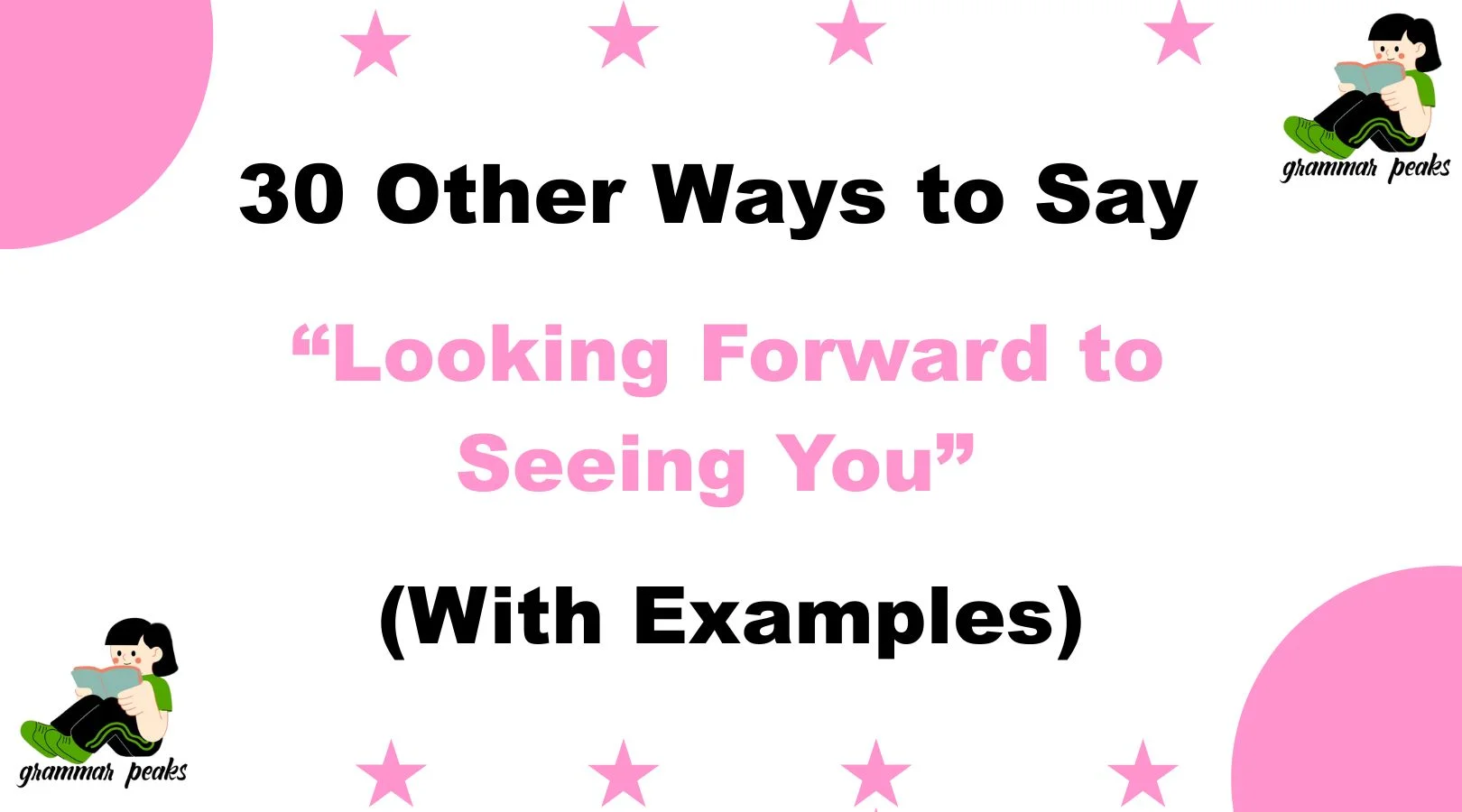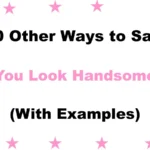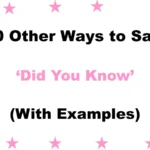When we’re anticipating meeting someone—whether it’s a colleague, friend, or loved one—how we express that excitement truly matters. Saying “Looking forward to seeing you” is warm and reliable, but it can sometimes feel repetitive or too standard. Finding a fresh, meaningful alternative helps you connect more personally, whether you’re writing a professional email, sending a text, or leaving a heartfelt note.
This guide offers 30 thoughtful and empathetic alternatives that not only preserve warmth and clarity but also make your message stand out and feel genuinely you. Let’s explore ways to express anticipation with style, sincerity, and professionalism.
What Does “Looking Forward to Seeing You” Mean?
The phrase “Looking forward to seeing you” is a polite and kind way of expressing anticipation or excitement about meeting someone in the future. It blends professionalism and emotional warmth, making it ideal in both business and personal contexts.
When to Use “Looking Forward to Seeing You”
Use it when you want to:
- End a message on a positive note
- Express courteous anticipation
- Confirm a future meeting, event, or visit
- Maintain a warm tone without being overly casual
Is It Professional/Polite to Say “Looking Forward to Seeing You”?
Yes, it’s both professional and polite.
This phrase strikes a perfect tone in emails, messages, and meetings. However, in highly formal documents, alternatives like “I await our meeting with anticipation” may sound more refined. In casual chats, something like “Can’t wait to see you” may feel more fitting.
Pros and Cons of Saying “Looking Forward to Seeing You”
Pros:
- Warm yet professional
- Easy to understand
- Versatile across situations
Cons:
- Can feel overused
- Lacks personalization
- Not always suitable for very formal or very casual moments
Synonyms for “Looking Forward to Seeing You”
- I’m eager to see you
- I can’t wait to see you
- Excited to see you soon
- Looking forward to our meeting
- Can’t wait to reconnect
- Awaiting our time together
- Counting down the days
- Anticipating our get-together
- Hope to see you soon
- Excited for our time ahead
- Happy to see you soon
- Can’t wait to catch up
- Looking ahead to seeing you
- Anticipating seeing you again
- Ready to see you
- Can’t wait for our meeting
- Counting the moments
- So excited to meet again
- Hope we cross paths soon
- Eagerly waiting to meet
- Happy for our upcoming meeting
- Looking forward to catching up
- Excited for the chance to see you
- I’ll be glad to see you
- Thrilled to meet again
- Can’t wait to be with you
- I’m ready for our meet-up
- Can’t wait to greet you
- Ready and excited to meet
- Let’s make it a great reunion
1. I’m Eager to See You
Definition: A clear expression of genuine interest in meeting someone.
Detailed Explanation: This alternative is both professional and warm, ideal when you want to emphasize excitement.
Scenario Example: “I’m eager to see you at the annual retreat next week.”
Best Use: Emails to coworkers, supervisors, or old friends.
Worst Use: Might be too formal for text messages with close friends.
Tone: Respectful, positive, and slightly formal.
2. I Can’t Wait to See You
Definition: A casual and heartfelt phrase showing strong anticipation.
Detailed Explanation: Great for friends or informal situations; less appropriate for corporate use.
Scenario Example: “I can’t wait to see you this weekend!”
Best Use: Friends, family, or informal professional messages.
Worst Use: Business letters or highly formal emails.
Tone: Energetic, personal, and warm.
3. Excited to See You Soon
Definition: Indicates upbeat anticipation in a casual but polite way.
Detailed Explanation: Balances enthusiasm with clarity.
Scenario Example: “Excited to see you soon and brainstorm our new project!”
Best Use: Professional meetings, casual texts, or friendly emails.
Worst Use: Highly formal invitations.
Tone: Friendly, collaborative, and informal.
4. Looking Forward to Our Meeting
Definition: A more formal take on the original phrase.
Detailed Explanation: Clear and courteous—perfect in professional contexts.
Scenario Example: “Looking forward to our meeting on Friday morning.”
Best Use: Business, interviews, or conference planning.
Worst Use: Texting friends or family.
Tone: Professional and respectful.
5. Can’t Wait to Reconnect
Definition: Emphasizes excitement about reuniting after time apart.
Detailed Explanation: Works well when you haven’t seen the person in a while.
Scenario Example: “Can’t wait to reconnect over coffee!”
Best Use: Long-distance friends, former colleagues.
Worst Use: First-time meetings.
Tone: Warm, friendly, and casual.
6. Awaiting Our Time Together
Definition: A slightly formal way of expressing upcoming plans.
Detailed Explanation: This phrase adds a sense of intention and grace.
Scenario Example: “Awaiting our time together next week in Boston.”
Best Use: Professional yet personal messages.
Worst Use: Too formal for casual text chats.
Tone: Respectful, calm, and refined.
7. Counting Down the Days
Definition: Suggests deep anticipation and emotional closeness.
Detailed Explanation: It shows excitement, typically used in close relationships.
Scenario Example: “Counting down the days until you arrive!”
Best Use: Friends, partners, family.
Worst Use: Business emails.
Tone: Affectionate and expressive.
8. Anticipating Our Get-Together
Definition: Neutral and polite—suits both personal and light-professional tones.
Detailed Explanation: Shows planning and excitement without going overboard.
Scenario Example: “Anticipating our get-together this Friday!”
Best Use: Friendly business relationships, casual meetups.
Worst Use: Formal invitations.
Tone: Balanced and pleasant.
9. Hope to See You Soon
Definition: Simple and widely used with a gentle emotional tone.
Detailed Explanation: A softer version that’s suitable for almost any situation.
Scenario Example: “Hope to see you soon at the seminar.”
Best Use: All-around safe choice for any relationship.
Worst Use: Might feel passive if strong interest is meant.
Tone: Neutral, sincere, and polite.
10. Excited for Our Time Ahead
Definition: Highlights enthusiasm for an upcoming shared experience.
Detailed Explanation: Feels thoughtful and optimistic without being overly emotional.
Scenario Example: “Excited for our time ahead during the strategy workshop.”
Best Use: Colleagues, teams, or partners.
Worst Use: Too vague for legal or formal letters.
Tone: Uplifting and collaborative.
11. Happy to See You Soon
Definition: A cheerful and positive way to express eagerness.
Detailed Explanation: This phrase carries a friendly, upbeat vibe suitable for casual and semi-formal use.
Scenario Example: “I’m happy to see you soon at the family gathering.”
Best Use: Social events, friendly work settings.
Worst Use: Formal or highly professional communications.
Tone: Warm, joyful, and informal.
12. Can’t Wait to Catch Up
Definition: Emphasizes eagerness to reconnect and share updates.
Detailed Explanation: Perfect for friends or colleagues you haven’t seen in a while.
Scenario Example: “Can’t wait to catch up during lunch next week!”
Best Use: Informal and semi-formal communication.
Worst Use: Formal business emails or first-time meetings.
Tone: Casual, excited, and friendly.
13. Looking Ahead to Seeing You
Definition: A slightly formal alternative indicating anticipation.
Detailed Explanation: It suggests optimism and positive expectation in a neutral tone.
Scenario Example: “Looking ahead to seeing you at the conference.”
Best Use: Professional emails and business contexts.
Worst Use: Very casual or informal settings.
Tone: Professional, polite, and optimistic.
14. Anticipating Seeing You Again
Definition: Shows expectation and excitement for a future encounter.
Detailed Explanation: Suitable when you have met the person before and expect to see them soon.
Scenario Example: “Anticipating seeing you again at the upcoming meeting.”
Best Use: Colleagues, clients, acquaintances.
Worst Use: First meetings or overly formal contexts.
Tone: Warm, professional, and thoughtful.
15. Ready to See You
Definition: A confident and straightforward way to express eagerness.
Detailed Explanation: It communicates preparedness and enthusiasm.
Scenario Example: “I’m ready to see you at the workshop on Monday.”
Best Use: Work or collaborative projects.
Worst Use: Romantic or very casual conversations (might feel too blunt).
Tone: Direct, enthusiastic, and confident.
16. Can’t Wait for Our Meeting
Definition: A clear expression of excitement focused on a scheduled meeting.
Detailed Explanation: Emphasizes anticipation for a professional or personal engagement.
Scenario Example: “Can’t wait for our meeting next Thursday to discuss the proposal.”
Best Use: Business meetings, interviews, networking.
Worst Use: Informal social meetups (too formal).
Tone: Professional, eager, and polite.
17. Counting the Moments
Definition: A poetic and emotional way of expressing anticipation.
Detailed Explanation: It shows heartfelt eagerness, often used with close friends or loved ones.
Scenario Example: “Counting the moments until we’re together again.”
Best Use: Romantic or close personal relationships.
Worst Use: Professional or casual acquaintances.
Tone: Emotional, warm, and intimate.
18. So Excited to Meet Again
Definition: A joyful expression emphasizing reunion excitement.
Detailed Explanation: Suitable for both personal and semi-formal contexts where familiarity exists.
Scenario Example: “So excited to meet again at the alumni event!”
Best Use: Friends, colleagues, or acquaintances you know.
Worst Use: Very formal or first-time meetings.
Tone: Cheerful, warm, and friendly.
19. Hope We Cross Paths Soon
Definition: A casual and somewhat poetic way to express hope for a meeting.
Detailed Explanation: Suggests anticipation but with a gentle, less certain tone.
Scenario Example: “Hope we cross paths soon at the conference.”
Best Use: Informal professional or casual encounters.
Worst Use: Formal business letters or direct appointments.
Tone: Casual, hopeful, and soft.
20. Eagerly Waiting to Meet
Definition: Shows strong anticipation with a slightly formal tone.
Detailed Explanation: Good for professional and social settings where you want to express keen interest.
Scenario Example: “Eagerly waiting to meet the new team members next week.”
Best Use: Professional meetings, social networking.
Worst Use: Overly casual chats.
Tone: Polite, eager, and positive.
21. Happy for Our Upcoming Meeting
Definition: Expresses positive feelings about a future engagement.
Detailed Explanation: Reflects enthusiasm and warmth with a professional touch.
Scenario Example: “Happy for our upcoming meeting to discuss the project.”
Best Use: Business and professional settings.
Worst Use: Casual conversations with friends.
Tone: Professional, warm, and positive.
22. Looking Forward to Catching Up
Definition: Indicates eagerness to reconnect and update each other.
Detailed Explanation: Ideal for friends or colleagues after some time apart.
Scenario Example: “Looking forward to catching up over coffee next week.”
Best Use: Semi-formal and informal settings.
Worst Use: Very formal or first-time encounters.
Tone: Friendly, casual, and warm.
23. Excited for the Chance to See You
Definition: Emphasizes gratitude and enthusiasm for the opportunity to meet.
Detailed Explanation: Useful when a meeting is special or less frequent.
Scenario Example: “Excited for the chance to see you at the annual gala.”
Best Use: Special events, professional or social.
Worst Use: Routine meetings.
Tone: Appreciative, warm, and enthusiastic.
24. I’ll Be Glad to See You
Definition: A polite and positive way to express anticipation.
Detailed Explanation: Suitable in both professional and personal contexts.
Scenario Example: “I’ll be glad to see you at the training session.”
Best Use: Formal and informal settings.
Worst Use: Very casual or slangy conversations.
Tone: Polite, warm, and straightforward.
25. Thrilled to Meet Again
Definition: A high-energy expression of excitement for a reunion.
Detailed Explanation: Best used when you have a warm relationship with the other person.
Scenario Example: “Thrilled to meet again and share ideas!”
Best Use: Close colleagues, friends, or team members.
Worst Use: Formal or distant relationships.
Tone: Enthusiastic, warm, and personal.
26. Can’t Wait to Be With You
Definition: Deeply personal and affectionate expression of anticipation.
Detailed Explanation: Perfect for close relationships, less suitable for professional use.
Scenario Example: “Can’t wait to be with you this weekend!”
Best Use: Romantic partners, close family.
Worst Use: Professional or casual acquaintances.
Tone: Loving, personal, and heartfelt.
27. I’m Ready for Our Meet-Up
Definition: Conveys preparedness and eagerness for a planned meeting.
Detailed Explanation: Shows professionalism with a casual tone.
Scenario Example: “I’m ready for our meet-up on Thursday to finalize details.”
Best Use: Semi-formal business meetings, casual professional events.
Worst Use: Highly formal or very casual texts.
Tone: Confident, practical, and polite.
28. Can’t Wait to Greet You
Definition: Focuses on the personal connection at the moment of meeting.
Detailed Explanation: Warm and polite, best for people you know well.
Scenario Example: “Can’t wait to greet you at the conference.”
Best Use: Friendly professional and personal meetings.
Worst Use: Formal letters or very casual messages.
Tone: Friendly, warm, and inviting.
29. Ready and Excited to Meet
Definition: Combines enthusiasm with readiness.
Detailed Explanation: Suitable for both professional and personal contexts where you want to show eagerness.
Scenario Example: “Ready and excited to meet the new team next week.”
Best Use: Professional and informal settings.
Worst Use: Overly casual or formal settings.
Tone: Energetic, warm, and polite.
30. Let’s Make It a Great Reunion
Definition: An inviting and optimistic phrase that looks forward to a joyful meeting.
Detailed Explanation: Best used when reconnecting with someone after a long time.
Scenario Example: “Let’s make it a great reunion at the annual meetup!”
Best Use: Friends, family, alumni groups.
Worst Use: Formal business meetings.
Tone: Warm, optimistic, and casual.
Conclusion
Finding the right way to say “looking forward to seeing you” can truly enrich your communication, whether formal or informal. Each alternative offers its own tone, level of formality, and warmth, allowing you to tailor your message to your audience thoughtfully. Whether you want to sound professional, friendly, or intimate, choosing the best phrase can help your message feel personal, sincere, and meaningful. Using these varied expressions thoughtfully also helps your communication stand out and fosters genuine connections—making every meeting feel even more special.
FAQs
1. What does “Looking Forward to Seeing You” really mean?
The phrase “Looking forward to seeing you” expresses a positive expectation and eagerness about meeting someone soon. It shows warmth and care, indicating that the upcoming encounter is anticipated with happiness or interest.
2. When is the best time to use “Looking Forward to Seeing You”?
This phrase is best used when you have a planned meeting or gathering with someone, whether in a personal or professional context. It works well in emails, messages, or conversations to convey polite excitement about a future interaction.
3. Is it professional to say “Looking Forward to Seeing You”?
Yes, “Looking forward to seeing you” is generally professional and polite. It is widely used in business communications to express eagerness for meetings or events in a respectful, positive manner.
4. Are there more formal alternatives to say “Looking Forward to Seeing You”?
Absolutely! Formal alternatives include “Anticipating our meeting,” “Eagerly awaiting our discussion,” or “Looking ahead to our appointment.” These phrases convey professionalism while maintaining warmth
5. Can I use these alternatives in casual conversations?
Many alternatives work well in casual settings, such as “Can’t wait to catch up” or “Counting the moments.” However, some phrases are best reserved for professional or formal use, so it’s important to match your wording to the situation and relationship.






